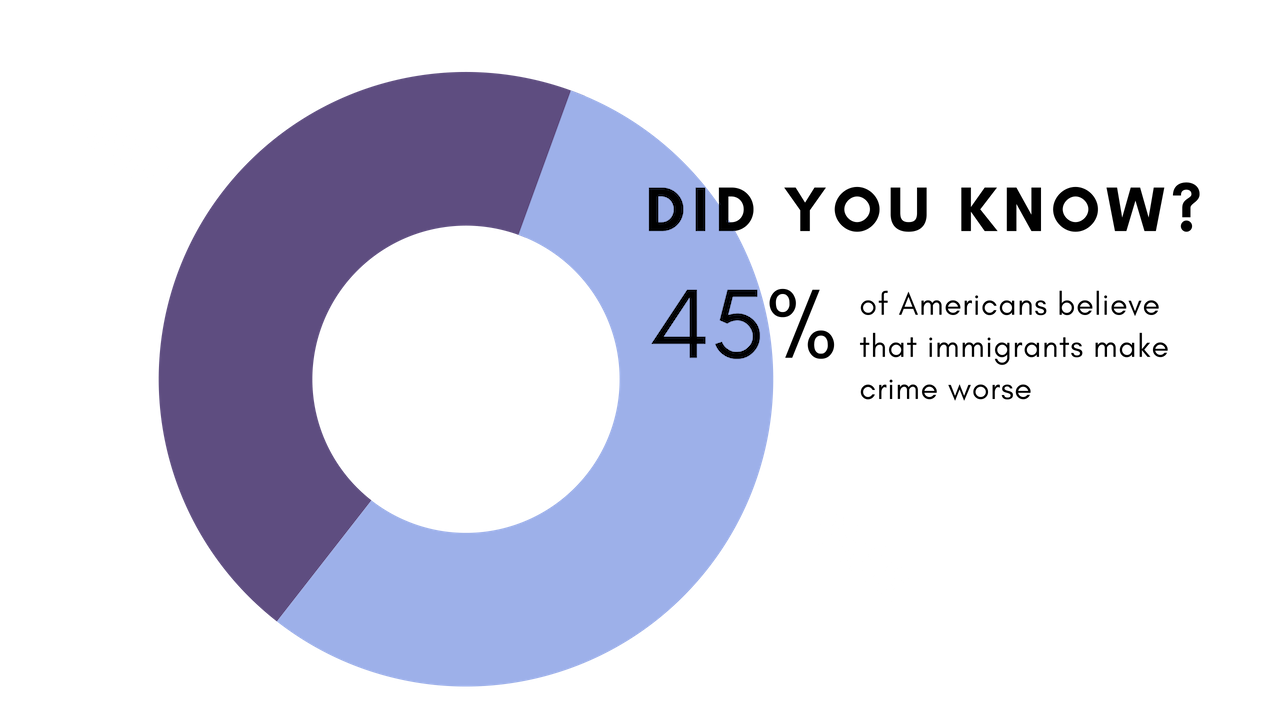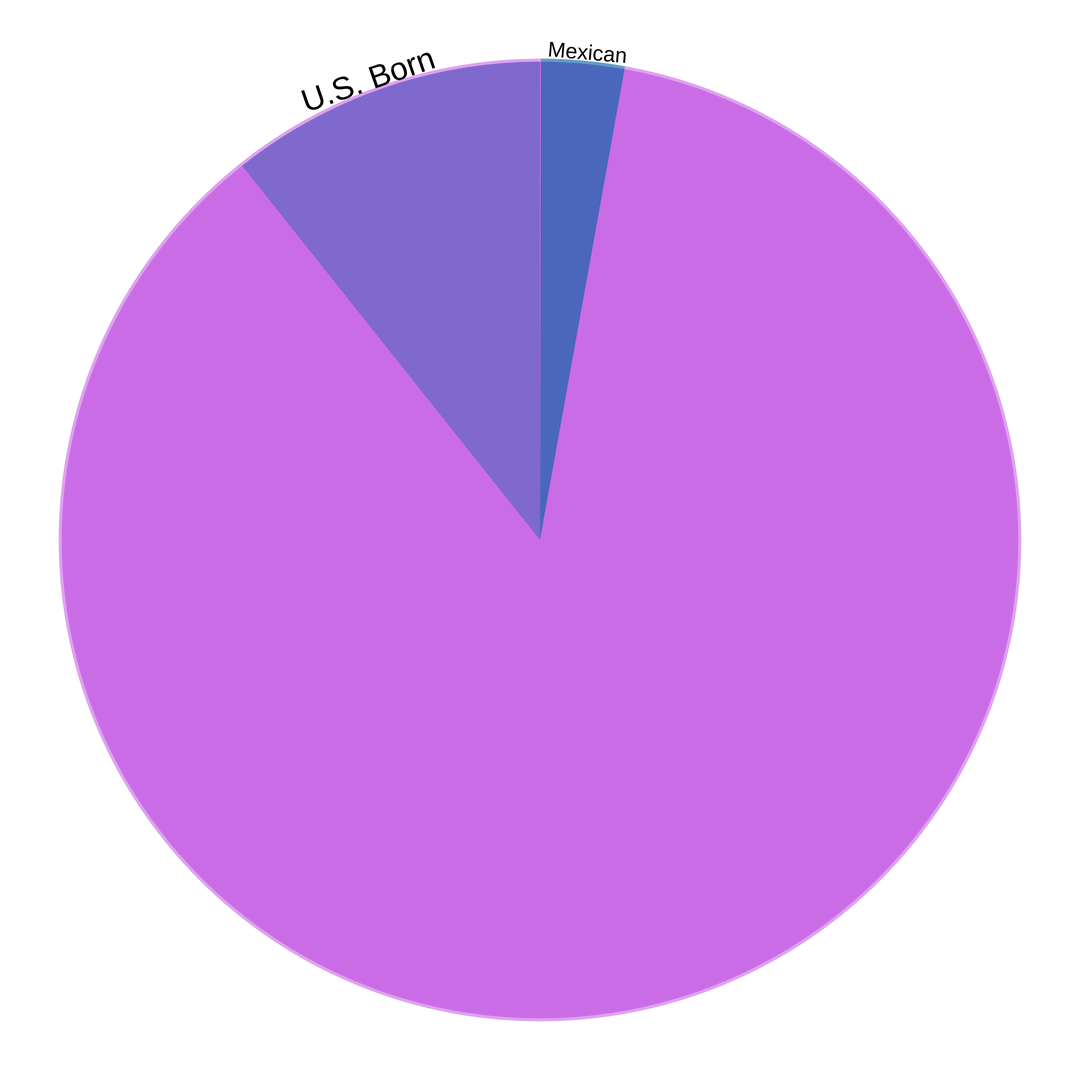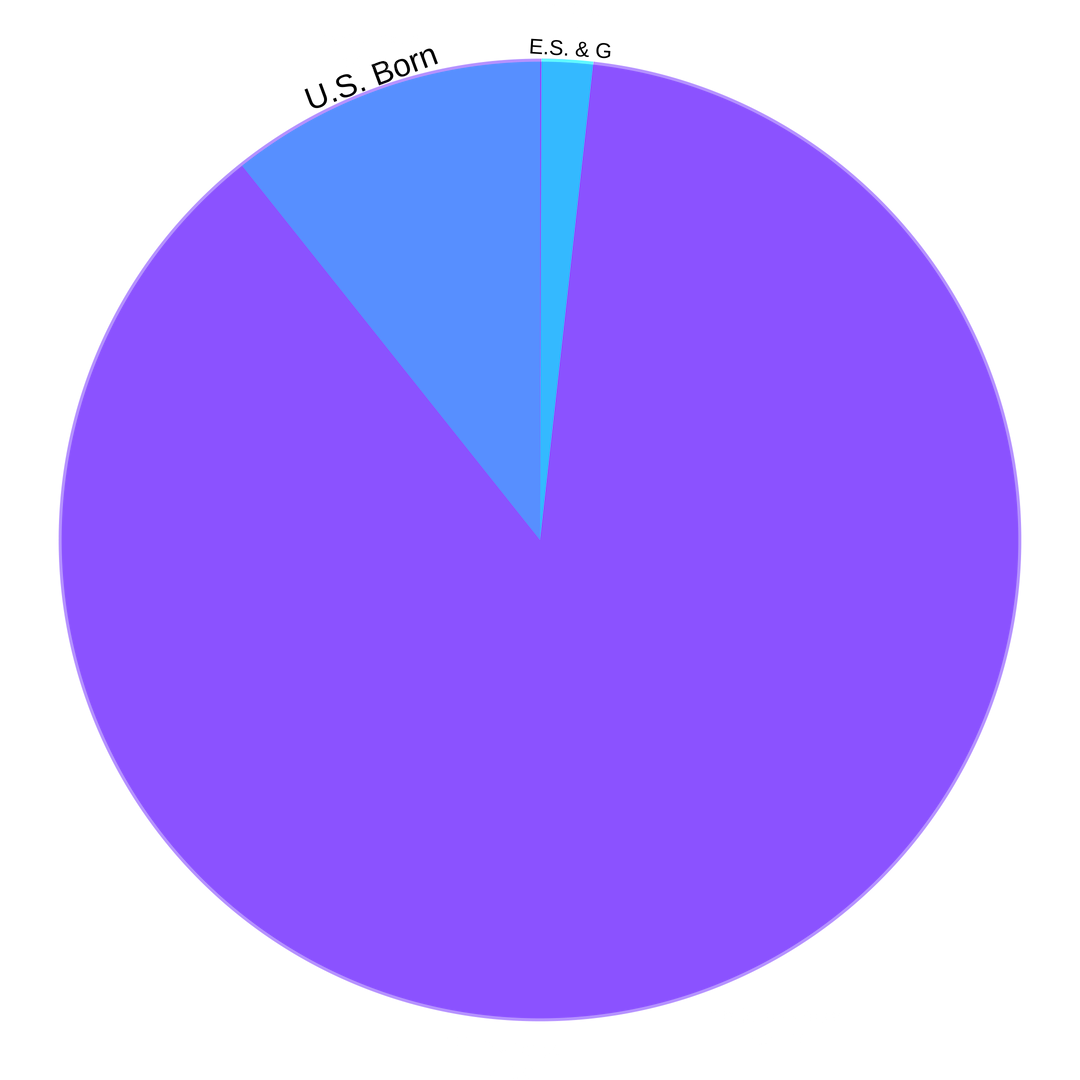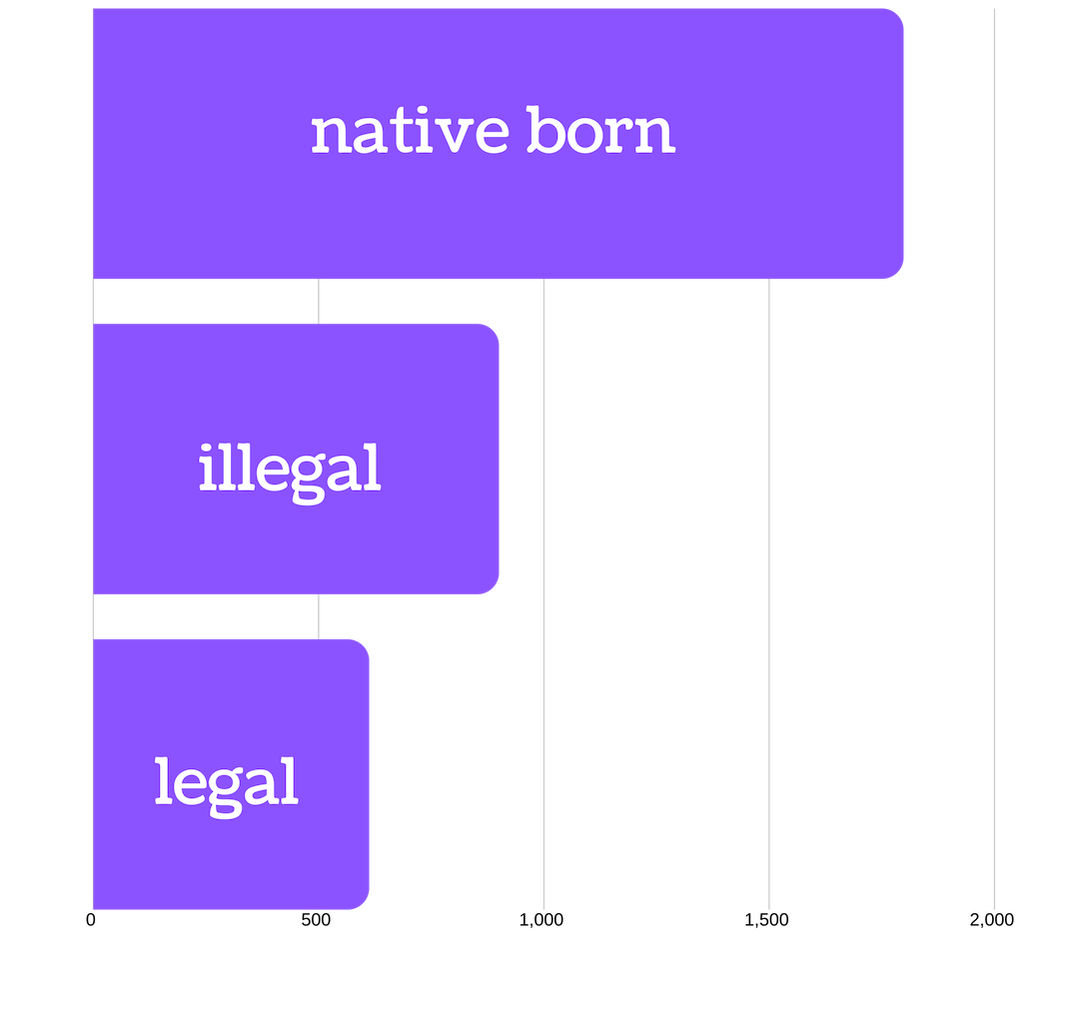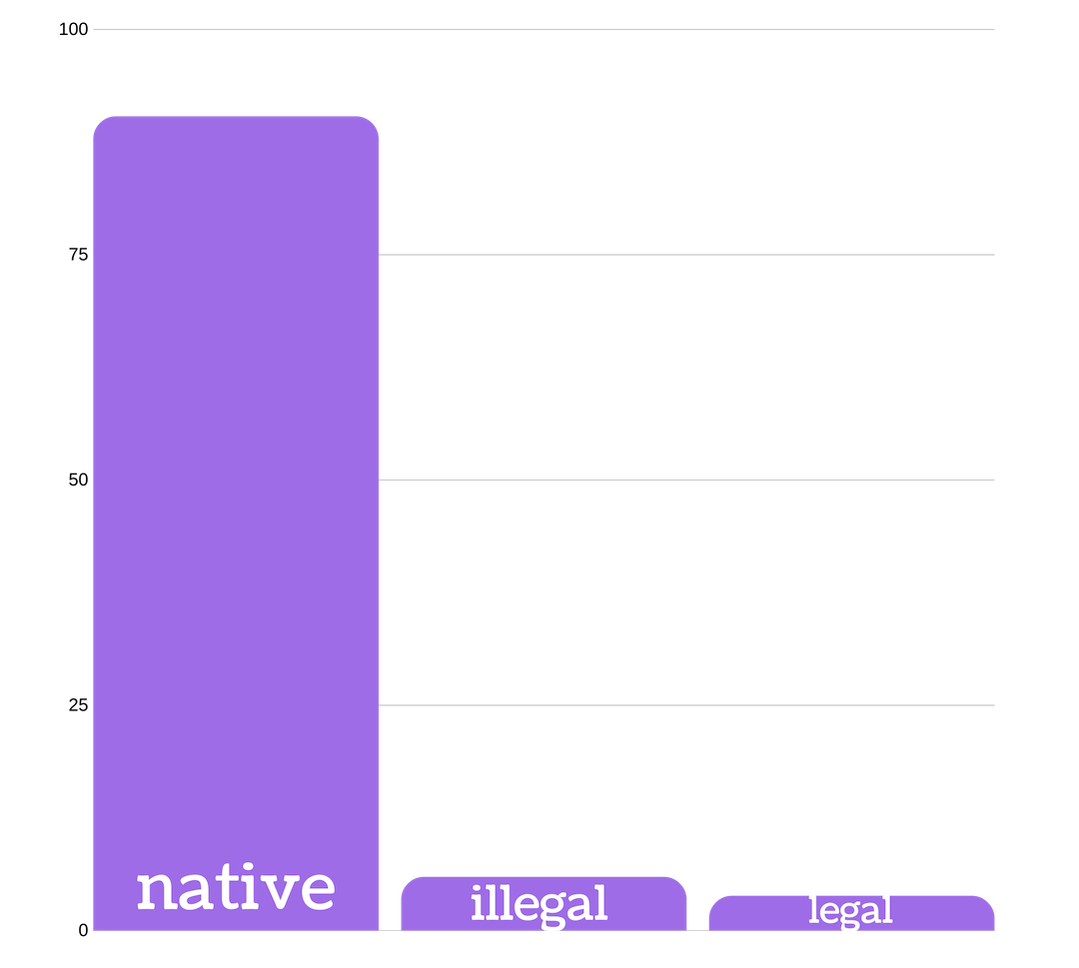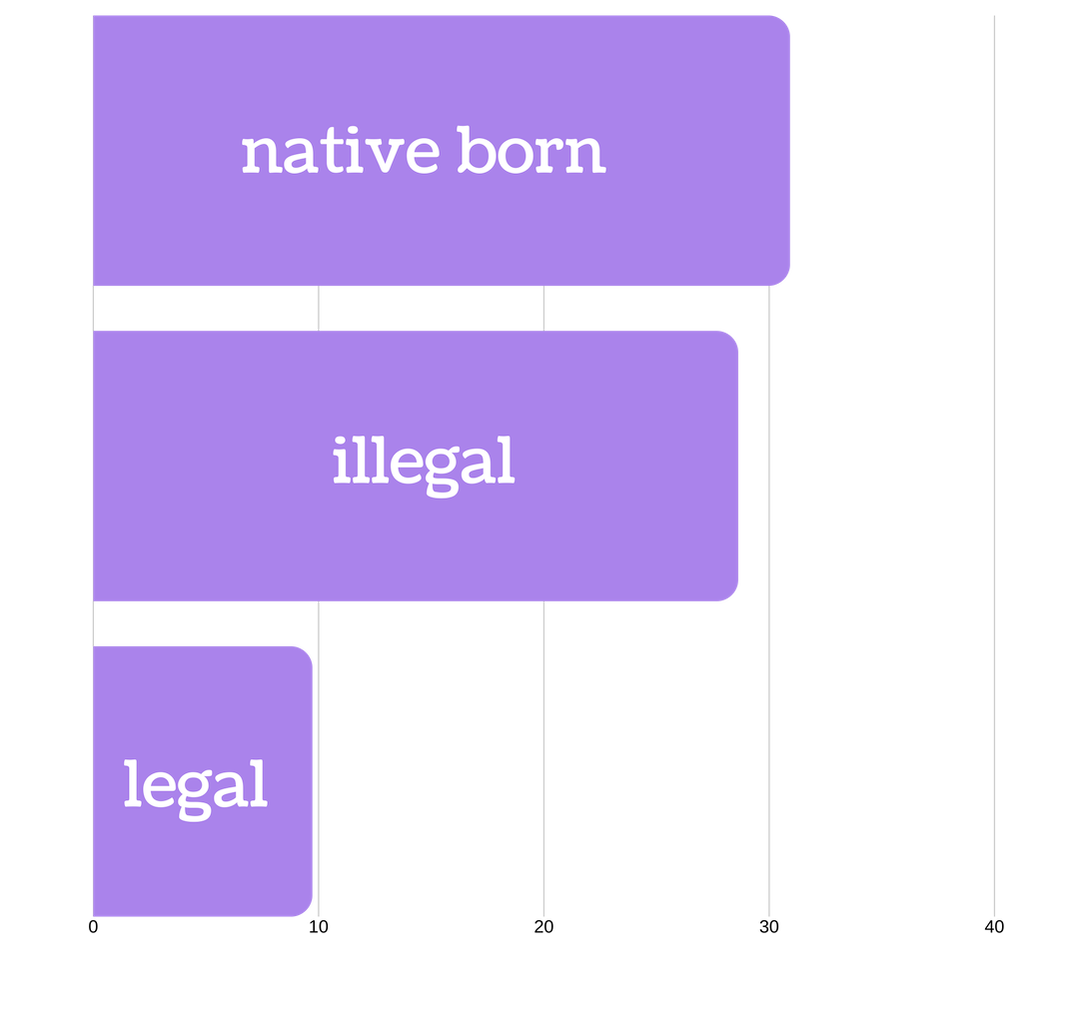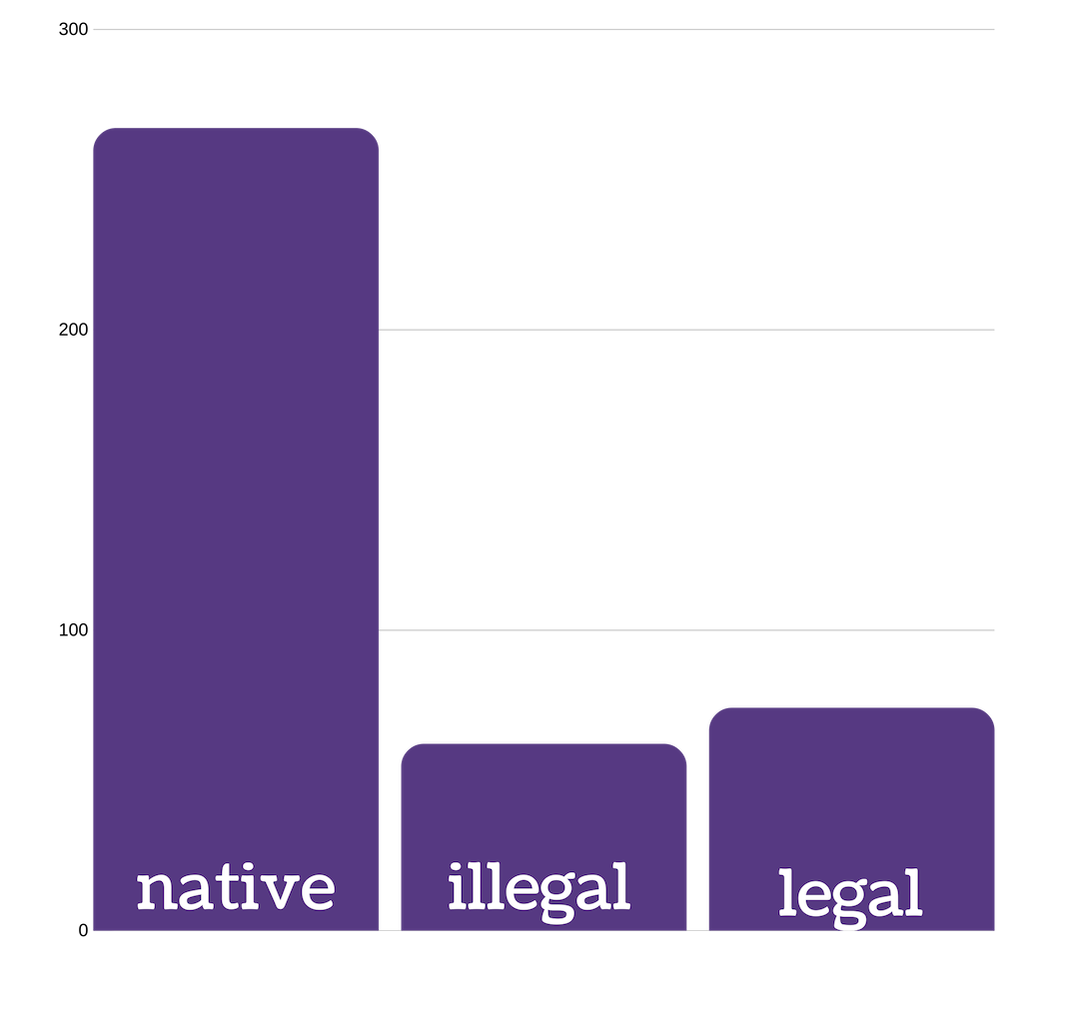When you think about it, it seems logical.
Most immigrants are young men, the most violent and crime committing population in the world. The better question is why wouldn’t they commit more crimes? [2]
But just because its logical does not mean that its true. The simple fact is that...
Most immigrants are young men, the most violent and crime committing population in the world. The better question is why wouldn’t they commit more crimes? [2]
But just because its logical does not mean that its true. The simple fact is that...
IMMIGRANTS DON’T ACTUALLY MAKE CRIME WORSE.
Overall, most studies on immigrants and crime show that immigrants commit fewer crimes than native-born Americans. [3] But, like anything in life there are a few exceptions [4]:
Exception #1:
Children of immigrants, for example, are more likely to commit crimes than their parents. When that’s true, immigration could have an indirect effect on increased crime. However, the crime rates of immigrant's children never exceed the crime rates of native-born Americans. [5] In fact, when you look at crime rates a little more critically, that particular trend seems to say more about immigrant assimilation than anything. Curious? Click here to learn more.
Exception #2:
Even though illegal immigrants aren’t actually more criminal than native-born Americans (more below!), some people do think they could have an indirect impact on crime rates. This is because if they put native Americans at an economic disadvantage by taking their jobs, natives may be more likely to commit crimes. But do immigrants actually steal our jobs? Click here to learn more. [6]
Exception #1:
Children of immigrants, for example, are more likely to commit crimes than their parents. When that’s true, immigration could have an indirect effect on increased crime. However, the crime rates of immigrant's children never exceed the crime rates of native-born Americans. [5] In fact, when you look at crime rates a little more critically, that particular trend seems to say more about immigrant assimilation than anything. Curious? Click here to learn more.
Exception #2:
Even though illegal immigrants aren’t actually more criminal than native-born Americans (more below!), some people do think they could have an indirect impact on crime rates. This is because if they put native Americans at an economic disadvantage by taking their jobs, natives may be more likely to commit crimes. But do immigrants actually steal our jobs? Click here to learn more. [6]
But how could this be? It’s because when looking at U.S. wide crime data, immigration is actually linked to lower violent and property crimes.
Violent Crime
For every 1% increase in immigrants, the overall violent crime rate decreases by 4.9 crimes. For murder in particular, the reduction is about 0.11 crimes and for robbery its 4.3 crimes. At first glance, these seem like really small numbers. For murder, it’s less than a 1 crime decrease! But keep in mind that murder is less common than other violent crimes like assault, so it makes sense that it would be a smaller number. Plus, murders are measured per 100,000 people. [7]
In a city like New York with 8,622,698 residents, that’s a potential decrease in almost 10 murders for every 1% increase in immigration. [8]
For every 1% increase in immigrants, the overall violent crime rate decreases by 4.9 crimes. For murder in particular, the reduction is about 0.11 crimes and for robbery its 4.3 crimes. At first glance, these seem like really small numbers. For murder, it’s less than a 1 crime decrease! But keep in mind that murder is less common than other violent crimes like assault, so it makes sense that it would be a smaller number. Plus, murders are measured per 100,000 people. [7]
In a city like New York with 8,622,698 residents, that’s a potential decrease in almost 10 murders for every 1% increase in immigration. [8]
Property Crime
Property crimes decrease even more than violent crimes when immigration increases. With every 1% increase in the immigrant population, property crimes decrease by 99 crimes per 100,000 people. Broken down, burglary goes down by 45 crimes and larceny by 54 crimes per 100,000 people. [9] In our same New York City example above, that means there could be a reduction of 8,514 crimes for every 1% increase in the immigrant population. [10]
In fact, if you look a little closer at those numbers they seem to show that immigration could even be making crime rates better. Some scholars even go as far to say that the over-all decline in crime in the US over recent decades is partly because of an increase in immigration. [11]
There are plenty of factors to consider when thinking about crime rates so we could use more research before being sure that that’s true. But about this the evidence is clear:
There are plenty of factors to consider when thinking about crime rates so we could use more research before being sure that that’s true. But about this the evidence is clear:
1. Immigrants are less likely to commit crimes than U.S.-born citizens. [12]
2. Immigration does not increase violent crime or crime in major cities. [13][14]
This is even true historically. Those old stereotypes about Irish, Italian, and Europeans as particularly crime prone? They aren’t actually true. Even back then immigrants were less criminal than natives. [15]
“Problem” Country Immigrants
Stereotypes about Latino immigrants makes them seem particularly crime prone. But when looking at Hispanic immigrants in particular the trends are the same:
Stereotypes about Latino immigrants makes them seem particularly crime prone. But when looking at Hispanic immigrants in particular the trends are the same:
But this data only looks at legal immigration. Isn’t the problem with illegal immigrants? They break the law when they come to the U.S. so wouldn’t they care less about following it once they actually live here?
Crime and Illegal Immigration
There are many theories on why undocumented immigrants might be more likely to commit crimes than documented ones. Let’s explore some of them:
There are many theories on why undocumented immigrants might be more likely to commit crimes than documented ones. Let’s explore some of them:
|
Theory #1: Because illegal immigrants can't legally work, they are more likely to participate in illegal activities to make money. [18]
Reality: Even though undocumented immigrants can’t technically work, they still do. In 2009, 93% of working-age illegal immigrant men were part of the labor force. [19] |
|
Theory #2: Because from a legal perspective, they live in the shadows, illegal immigrants have less trust in and relationships with government officials like the police. This might encourage them to turn to crime to solve their problems instead of working through the proper legal channels. [20]
Reality: It’s possible. But most illegal immigrants’ primary concern is deportation. That’s a strong incentive to avoid criminal involvement. [21] |
|
Theory #3: Population structure tell us that illegal immigrants must be more violent since the majority of illegals are young men, the population most likely to commit crimes. [22]
Reality: Most illegal immigrants are driven by the educational and economic opportunities offered in the United States. Because of this they are usually highly motivated to work and achieve, qualities that are unlikely to lead to criminal behavior. [23] |
Plus, you've heard about chain migration, right?
Well, as surprising as it sounds, it's actually good for crime. Having family and friends already living in the U.S. cushions migrant communities with social organizations and institutions. These organizations (like church groups, companies owned by immigrants, circles of friends and family) shelter immigrants from economic hardships and poverty by giving them social networks (friends!), childcare, housing, transportation assistance, and many other things. [24]
Overall, less poverty means less crime in immigrant communities. And, similar to the data on lawfully present immigrants, data on unlawful migrants shows some clear patterns:
Well, as surprising as it sounds, it's actually good for crime. Having family and friends already living in the U.S. cushions migrant communities with social organizations and institutions. These organizations (like church groups, companies owned by immigrants, circles of friends and family) shelter immigrants from economic hardships and poverty by giving them social networks (friends!), childcare, housing, transportation assistance, and many other things. [24]
Overall, less poverty means less crime in immigrant communities. And, similar to the data on lawfully present immigrants, data on unlawful migrants shows some clear patterns:
- 1. Statistically, undocumented immigration is generally associated with a reduction in violent crime. [25]
- 2. Illegal immigrants have lower incarceration rates nationwide. [26]
- 3. When illegal immigrants are apprehended by immigration enforcement officials, there is no effect on local crime rates. [27]
So, what does this mean?
In a nutshell, most illegal immigrants aren’t criminals either.
Not convinced yet? Let’s take a look at a more specific example, Texas:
|
Case Study: Texas
Texas is a state with a huge immigrant population, especially immigrants from Latin America. In particular, Texas is home to a large Mexican population. Yet, according to this study by the Cato Institute, both legal and illegal immigrants in Texas are less likely to commit crimes than native-born Americans. [28] |
Criminal Convictions
In Texas, for every 100,000 native-born Americans, there were about 1,797 criminal convictions. For illegal immigrants that number drops to 899 convictions. For legal immigrants its even lower at 611 convictions. [29]
In Texas, for every 100,000 native-born Americans, there were about 1,797 criminal convictions. For illegal immigrants that number drops to 899 convictions. For legal immigrants its even lower at 611 convictions. [29]
Homicide
Illegal immigrants made up about 6.4 percent of the Texas population in 2015 but only 5.9 percent of all homicide convictions. Legal immigrants made up 10.6 percent of the Texas population but only 3.8 percent of homicide convictions. Native-born Americans, though? They made up 83 percent of the Texas population and accounted for a whopping 90.3 percent of all homicide convictions.
Sex Crimes
“There were 28.6 sex crime convictions of illegal immigrants per 100,000 in 2015, about 7.9 percent fewer than for native-born Americans in the same year. The sex crime conviction rate for legal immigrants was 69 percent below that of natives.” [32]
Larceny
In 2015 there were 267 larceny convictions of natives per 100,000 people. There were about 74 larceny convictions against legal immigrants per 100,000. Illegal immigrants? There were only about 62 convictions against them, making their larceny conviction rate 77% below the native rate. [34]
Sources:
Looking for another case study example? Check out this study on California, another state with a huge immigrant population.
Further reading/summaries
Sources Referenced:
[1] https://news.gallup.com/poll/1660/immigration.aspx; We went with the lower stat, 45% from Gallup. See question "For each of the following areas, please say whether immigrants to the United States are making the situation in the country better or worse, or not having much effect. How about -- [RANDOM ORDER]?” in the section called “The Crime Situation.” PEW has another stat at 50% from paragraph three of “How do Americans view immigrants and immigration?” here. Data is as of 2017.
[2] https://www.nap.edu/read/21746/chapter/9; The Integration of Immigrants into American Society: Chapter 7, Sociocultural Dimensions of Immigrant Integration. Page 327, see “Crime” section
[3] http://dx.doi.org/10.1080/15377938.2016.1261057; This is one source but this has been repeatedly shown: See the studies listed on pages 55-56 for more sources (i.e. Bersani, Harris, Sampson, Morenoff & Rudebush, Sampson), page 327 of the literature review from Martinez and Lee, 2000 and page 3 of this Cato Institute study.
[4] http://dx.doi.org/10.1080/15377938.2016.1261057; see page 53 of the Abstract (Source is "Urban Crime Rates and the Changing Race of Immigration: Evidence across four decades" by Robert Adelman, Lesley Williams Reid, Gail Markle, Saskia Weiss, Charles Jaret)
[5] http://dx.doi.org/10.1080/15377938.2016.1261057; see page 56; also, "The Integration of Immigrants into American Society" page 329.
[6] https://onlinelibrary.wiley.com/doi/epdf/10.1111/1745-9125.12175; see page 374. Exact quote is "could increase overall crime by putting native low-skilled US workers at an economic disadvantage by taking their economic opportunities and jobs. These natives could then turn to crime to better their own economic positions."
[7] https://www.tandfonline.com/doi/full/10.1080/15377938.2016.1261057; see page 53
[8] https://www1.nyc.gov/site/planning/data-maps/nyc-population/current-future-populations.page; data comes from this site but we did our own calculations: 8,622,698 (total pop) / 100,000 (population measurement) = ~86 * .11 (crimes per 100,000 people) = 9.46, round up to 10 --> crime decrease in New York
[9] https://www.tandfonline.com/doi/full/10.1080/15377938.2016.1261057; see page 56
[10] https://www1.nyc.gov/site/planning/data-maps/nyc-population/current-future-populations.page; data comes from this site but we did our own calculations: 8,622,698 (total pop) / 100,000 (population measurement) = ~86 * 99 (crimes per 100,000 people) = 8,514, round down to 8,500 --> potential crime decrease in New York
[11] https://www.nap.edu/read/21746/chapter/9; see page 331. Have access to academic journals? Then also see Sampson (2008), Stowell and Martinez (2009), and Wadsworth (2010).
[12] https://www.nap.edu/read/21746/chapter/9; page 326. Also, see page 3 of this Cato Study. The direct quote says: “The vast majority of research finds that immigrants do not increase local crime rates and that they are less likely to cause crime and less likely to be incarcerated than their native-born peers.”
[13] https://onlinelibrary.wiley.com/doi/epdf/10.1111/1745-9125.12175, see abstract on page 370
[14] https://www.nap.edu/read/21746/chapter/9; see pages 330 and 331. This is true at the metropolitan and the local level and both over time and in isolated studies.
[15] https://www.nap.edu/read/21746/chapter/9; see page 326. Have access to academic articles? If so, also see Moehling and Piehl, 2009
[16] https://www.nap.edu/read/21746/chapter/9; see page 329. Direct quote: 'Ewing and colleagues (2015, p. 7) found that “[I]n 2010, less educated native born men age 18-39 had an incarceration rate of 10.7 percent—more than triple the 2.8 percent rate among foreign born Mexican men, and five times greater than the 1.7 percent rate among foreign born Salvadoran and Guatemalan men.”'
[17] https://www.nap.edu/read/21746/chapter/9; see page 329. Direct quote: 'Ewing and colleagues (2015, p. 7) found that “[I]n 2010, less educated native born men age 18-39 had an incarceration rate of 10.7 percent—more than triple the 2.8 percent rate among foreign born Mexican men, and five times greater than the 1.7 percent rate among foreign born Salvadoran and Guatemalan men.”'
[18] https://onlinelibrary.wiley.com/doi/epdf/10.1111/1745-9125.12175; see page 373. Direct quote: "Their formal exclusion from the labor market may cause them an economic disadvantage forcing them to participate in more illicit activities to make money,"
[19] https://onlinelibrary.wiley.com/doi/epdf/10.1111/1745-9125.12175; see page 375. Direct quote, “despite their legal exclusion from the labor market, a full 93 percent of working-age unauthorized immigrant men were in the labor force in 2009 (Donato and Armenta, 2011).”
[20] https://onlinelibrary.wiley.com/doi/epdf/10.1111/1745-9125.12175; see page 373
[21] https://onlinelibrary.wiley.com/doi/epdf/10.1111/1745-9125.12175; see page 375
[22] https://onlinelibrary.wiley.com/doi/epdf/10.1111/1745-9125.12175; see page 374
[23] https://onlinelibrary.wiley.com/doi/epdf/10.1111/1745-9125.12175; see page 374
[24] https://onlinelibrary.wiley.com/doi/epdf/10.1111/1745-9125.12175; see page 375
[25] https://onlinelibrary.wiley.com/doi/epdf/10.1111/1745-9125.12175, (Time period = 1990-2014) and https://www.nap.edu/read/21746/chapter/9
[26] https://object.cato.org/sites/cato.org/files/pubs/pdf/irpb-4-updated.pdf (see background section)
[27] https://object.cato.org/sites/cato.org/files/pubs/pdf/irpb-4-updated.pdf (see background section); Direct quote: “immigration enforcement programs targeting illegal immigrant criminals have no effect on local crime rates, which indicates that they are about as crime prone as other residents”
[28] Keep in mind that the Cato Institute is a Libertarian research organization with its own agenda and biases. But, the Libertarian Political Party is neither democrat or republican making it an interesting source of potentially bi-partisan information.
[29] https://object.cato.org/sites/cato.org/files/pubs/pdf/irpb-4-updated.pdf Page 2, cato study
[30] https://object.cato.org/sites/cato.org/files/pubs/pdf/irpb-4-updated.pdf Page 2, see figure 3.
[31] https://object.cato.org/sites/cato.org/files/pubs/pdf/irpb-4-updated.pdf Page 2, see figure 3.
[32] https://object.cato.org/sites/cato.org/files/pubs/pdf/irpb-4-updated.pdf Page 2, see figure 4.
[33] https://object.cato.org/sites/cato.org/files/pubs/pdf/irpb-4-updated.pdf Page 2, see figure 3.
[34] https://object.cato.org/sites/cato.org/files/pubs/pdf/irpb-4-updated.pdf Page 3, see figure 5
[35] https://object.cato.org/sites/cato.org/files/pubs/pdf/irpb-4-updated.pdf Page 2, see figure 3.
Further reading/summaries
- https://www.nytimes.com/interactive/2018/03/30/upshot/crime-immigration-myth.html
- https://www.washingtonpost.com/news/the-fix/wp/2015/07/02/surprise-donald-trump-is-wrong-about-immigrants-and-crime/?utm_term=.eed478de4a2b
- https://www.politifact.com/california/statements/2017/aug/03/antonio-villaraigosa/mostly-true-undocumented-immigrants-less-likely-co/
- https://www.washingtonpost.com/news/wonk/wp/2018/06/19/two-charts-demolish-the-notion-that-immigrants-here-illegally-commit-more-crime/?utm_term=.a55022359445
Sources Referenced:
[1] https://news.gallup.com/poll/1660/immigration.aspx; We went with the lower stat, 45% from Gallup. See question "For each of the following areas, please say whether immigrants to the United States are making the situation in the country better or worse, or not having much effect. How about -- [RANDOM ORDER]?” in the section called “The Crime Situation.” PEW has another stat at 50% from paragraph three of “How do Americans view immigrants and immigration?” here. Data is as of 2017.
[2] https://www.nap.edu/read/21746/chapter/9; The Integration of Immigrants into American Society: Chapter 7, Sociocultural Dimensions of Immigrant Integration. Page 327, see “Crime” section
[3] http://dx.doi.org/10.1080/15377938.2016.1261057; This is one source but this has been repeatedly shown: See the studies listed on pages 55-56 for more sources (i.e. Bersani, Harris, Sampson, Morenoff & Rudebush, Sampson), page 327 of the literature review from Martinez and Lee, 2000 and page 3 of this Cato Institute study.
[4] http://dx.doi.org/10.1080/15377938.2016.1261057; see page 53 of the Abstract (Source is "Urban Crime Rates and the Changing Race of Immigration: Evidence across four decades" by Robert Adelman, Lesley Williams Reid, Gail Markle, Saskia Weiss, Charles Jaret)
[5] http://dx.doi.org/10.1080/15377938.2016.1261057; see page 56; also, "The Integration of Immigrants into American Society" page 329.
[6] https://onlinelibrary.wiley.com/doi/epdf/10.1111/1745-9125.12175; see page 374. Exact quote is "could increase overall crime by putting native low-skilled US workers at an economic disadvantage by taking their economic opportunities and jobs. These natives could then turn to crime to better their own economic positions."
[7] https://www.tandfonline.com/doi/full/10.1080/15377938.2016.1261057; see page 53
[8] https://www1.nyc.gov/site/planning/data-maps/nyc-population/current-future-populations.page; data comes from this site but we did our own calculations: 8,622,698 (total pop) / 100,000 (population measurement) = ~86 * .11 (crimes per 100,000 people) = 9.46, round up to 10 --> crime decrease in New York
[9] https://www.tandfonline.com/doi/full/10.1080/15377938.2016.1261057; see page 56
[10] https://www1.nyc.gov/site/planning/data-maps/nyc-population/current-future-populations.page; data comes from this site but we did our own calculations: 8,622,698 (total pop) / 100,000 (population measurement) = ~86 * 99 (crimes per 100,000 people) = 8,514, round down to 8,500 --> potential crime decrease in New York
[11] https://www.nap.edu/read/21746/chapter/9; see page 331. Have access to academic journals? Then also see Sampson (2008), Stowell and Martinez (2009), and Wadsworth (2010).
[12] https://www.nap.edu/read/21746/chapter/9; page 326. Also, see page 3 of this Cato Study. The direct quote says: “The vast majority of research finds that immigrants do not increase local crime rates and that they are less likely to cause crime and less likely to be incarcerated than their native-born peers.”
[13] https://onlinelibrary.wiley.com/doi/epdf/10.1111/1745-9125.12175, see abstract on page 370
[14] https://www.nap.edu/read/21746/chapter/9; see pages 330 and 331. This is true at the metropolitan and the local level and both over time and in isolated studies.
[15] https://www.nap.edu/read/21746/chapter/9; see page 326. Have access to academic articles? If so, also see Moehling and Piehl, 2009
[16] https://www.nap.edu/read/21746/chapter/9; see page 329. Direct quote: 'Ewing and colleagues (2015, p. 7) found that “[I]n 2010, less educated native born men age 18-39 had an incarceration rate of 10.7 percent—more than triple the 2.8 percent rate among foreign born Mexican men, and five times greater than the 1.7 percent rate among foreign born Salvadoran and Guatemalan men.”'
[17] https://www.nap.edu/read/21746/chapter/9; see page 329. Direct quote: 'Ewing and colleagues (2015, p. 7) found that “[I]n 2010, less educated native born men age 18-39 had an incarceration rate of 10.7 percent—more than triple the 2.8 percent rate among foreign born Mexican men, and five times greater than the 1.7 percent rate among foreign born Salvadoran and Guatemalan men.”'
[18] https://onlinelibrary.wiley.com/doi/epdf/10.1111/1745-9125.12175; see page 373. Direct quote: "Their formal exclusion from the labor market may cause them an economic disadvantage forcing them to participate in more illicit activities to make money,"
[19] https://onlinelibrary.wiley.com/doi/epdf/10.1111/1745-9125.12175; see page 375. Direct quote, “despite their legal exclusion from the labor market, a full 93 percent of working-age unauthorized immigrant men were in the labor force in 2009 (Donato and Armenta, 2011).”
[20] https://onlinelibrary.wiley.com/doi/epdf/10.1111/1745-9125.12175; see page 373
[21] https://onlinelibrary.wiley.com/doi/epdf/10.1111/1745-9125.12175; see page 375
[22] https://onlinelibrary.wiley.com/doi/epdf/10.1111/1745-9125.12175; see page 374
[23] https://onlinelibrary.wiley.com/doi/epdf/10.1111/1745-9125.12175; see page 374
[24] https://onlinelibrary.wiley.com/doi/epdf/10.1111/1745-9125.12175; see page 375
[25] https://onlinelibrary.wiley.com/doi/epdf/10.1111/1745-9125.12175, (Time period = 1990-2014) and https://www.nap.edu/read/21746/chapter/9
[26] https://object.cato.org/sites/cato.org/files/pubs/pdf/irpb-4-updated.pdf (see background section)
[27] https://object.cato.org/sites/cato.org/files/pubs/pdf/irpb-4-updated.pdf (see background section); Direct quote: “immigration enforcement programs targeting illegal immigrant criminals have no effect on local crime rates, which indicates that they are about as crime prone as other residents”
[28] Keep in mind that the Cato Institute is a Libertarian research organization with its own agenda and biases. But, the Libertarian Political Party is neither democrat or republican making it an interesting source of potentially bi-partisan information.
[29] https://object.cato.org/sites/cato.org/files/pubs/pdf/irpb-4-updated.pdf Page 2, cato study
[30] https://object.cato.org/sites/cato.org/files/pubs/pdf/irpb-4-updated.pdf Page 2, see figure 3.
[31] https://object.cato.org/sites/cato.org/files/pubs/pdf/irpb-4-updated.pdf Page 2, see figure 3.
[32] https://object.cato.org/sites/cato.org/files/pubs/pdf/irpb-4-updated.pdf Page 2, see figure 4.
[33] https://object.cato.org/sites/cato.org/files/pubs/pdf/irpb-4-updated.pdf Page 2, see figure 3.
[34] https://object.cato.org/sites/cato.org/files/pubs/pdf/irpb-4-updated.pdf Page 3, see figure 5
[35] https://object.cato.org/sites/cato.org/files/pubs/pdf/irpb-4-updated.pdf Page 2, see figure 3.
